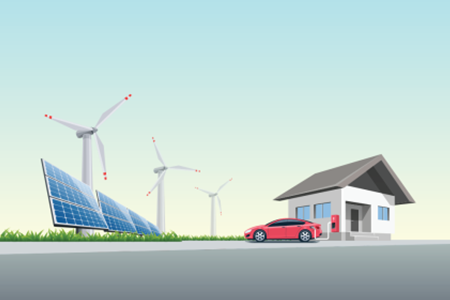Bidirectional charging is shaping up to be a game changer in how we manage our energy use. But first, it needs to show up in more EVs.

It was a football game on TV that sparked Nancy Skinner’s interest in bidirectional charging, an emerging technology that allows an EV’s battery to not just soak up energy but to discharge it, too — to a home, to other cars or even back to the utility grid.
“There was a commercial for the Ford F-150 truck,” recalls Skinner, a California state senator who represents San Francisco’s East Bay. “This guy is driving up to the mountains and plugs his truck into a cabin. Not to charge the truck, but to power the cabin.”
With its 98-kWh battery, an F-150 Lightning can keep the power on for up to three days. That could be extremely useful in California, which has seen nearly 100 substantial outages in the last five years, more than any other state except Texas. In September 2022, a 10-day heat wave saw California’s power grid reach an all-time high of more than 52,000 megawatts, nearly knocking the electric grid offline.
In January, Skinner introduced Senate Bill 233, which would require all electric cars, light-duty trucks and school buses sold in California to support bidirectional charging by model year 2030 — five years before the state is set to ban the sale of new gas-powered cars. A mandate for bidirectional charging would ensure that carmakers “can’t just put a premium price on a feature,” said Skinner.
“Everyone has to have it,” she added. “If they choose to utilize it to help offset high electricity prices, or to power their home during a blackout, they’ll have that option.”
SB-233 cleared the state Senate in May by a 29-9 vote. Not long after, several automakers, including GM and Tesla, announced that they’d be making bidirectional charging standard in upcoming EV models. Currently, the F-150 and the Nissan Leaf are the only EVs available in North America with bidirectional charging enabled beyond the most rudimentary capability.
But progress doesn’t always move in a straight line: In September, SB-233 died in committee in the California Assembly. Skinner says she’s looking for “a new path” to ensure that all Californians benefit from bidirectional charging.
As natural disasters, severe weather and other effects of climate change become more evident, Americans are increasingly turning to renewable energy options like electric vehicles and solar power. Falling prices on EVs and new tax credits and incentives are helping to speed that transition.
Now the prospect of bidirectional charging offers yet another reason for considering EVs: the potential to use your car as a backup power source that could save you in a blackout or earn money when you’re not using it.
To be sure, there are some road bumps ahead. Manufacturers and municipalities are just beginning to examine the infrastructure changes they’ll need to scale up to make this feature useful. Necessary accessories are unavailable or expensive. And there’s a lot of educating to be done for consumers, too.
What’s clear, though, is that this technology has the potential to dramatically change the way we power our lives.
Post time: Oct-26-2023

 Portable EV Charger
Portable EV Charger Home EV Wallbox
Home EV Wallbox DC Charger Station
DC Charger Station EV Charging Module
EV Charging Module NACS&CCS1&CCS2
NACS&CCS1&CCS2 EV Accessories
EV Accessories
